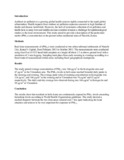| dc.contributor.author | Egondi, Thaddaeus | |
| dc.contributor.author | Muindi, Kanyiva | |
| dc.contributor.author | Kyobutungi, Catherine | |
| dc.contributor.author | Gatari, Michael | |
| dc.contributor.author | Rocklöv, Joacim | |
| dc.date.accessioned | 2016-12-09T06:47:44Z | |
| dc.date.available | 2016-12-09T06:47:44Z | |
| dc.date.issued | 2016-07 | |
| dc.identifier.citation | Environmental Research Volume 148, July 2016, Pages 500–506 | en_US |
| dc.identifier.uri | http://www.sciencedirect.com/science/article/pii/S0013935116300974 | |
| dc.identifier.uri | http://hdl.handle.net/11295/97947 | |
| dc.description.abstract | Introduction
Ambient air pollution is a growing global health concern tightly connected to the rapid global urbanization. Health impacts from outdoor air pollution exposure amounts to high burdens of deaths and disease worldwide. However, the lack of systematic collection of air pollution and health data in many low-and middle-income countries remains a challenge for epidemiological studies in the local environment. This study aimed to provide a description of the particulate matter (PM2.5) concentration in the poorest urban residential areas of Nairobi, Kenya.
Methods
Real-time measurements of (PM2.5) were conducted in two urban informal settlements of Nairobi City, Kenya”s Capital, from February 2013 to October 2013. The measurements were conducted using DustTrak II 8532 hand-held samplers at a height of about 1.5 m above ground level with a resolution of 1-min logging. Sampling took place from early morning to evenings according to a fixed route of measurement within areas including fixed geographical checkpoints.
Results
The study period average concentration of PM2.5 was 166 μg/m3 in the Korogocho area and 67 μg/m3 in the Viwandani area. The PM2.5 levels in both areas reached bimodal daily peaks in the morning and evening. The average peak value of morning concentration in Korogocho was 214 μg/m3, and 164 μg/m3 in the evening and in Viwandani was 76 μg/m3 and 82 μg/m3 respectively. The daily mid-day average low observed during was 146 μg/m3 in Korogocho and 59 μg/m3 in Viwandani.
Conclusion
The results show that residents in both slums are continuously exposed to PM2.5 levels exceeding hazardous levels according to World Health Organization guidelines. The study showed a marked disparity between the two slum areas situated only 7 km apart indicating the local situation and sources to be very important for exposure to PM2.5. | en_US |
| dc.language.iso | en | en_US |
| dc.publisher | University of Nairobi | en_US |
| dc.subject | Particulate matter; Urban pollution; Exposure; Air pollution; Assessment; Slum; PM2.5; Low- and middle-income country | en_US |
| dc.title | Measuring exposure levels of inhalable airborne particles (PM2.5) in two socially deprived areas of Nairobi, Kenya | en_US |
| dc.type | Article | en_US |

